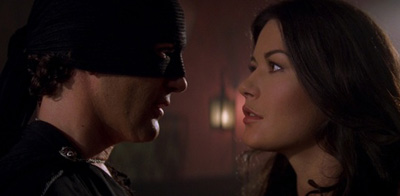Are You With Us?
The Mask of Zorro
By Ryan Mazie
July 18, 2011
I love the movie theater pre-show trivia; so, here is my own attempt at a question. Spanish hero Zorro was first published in 1919 and then jumped to movies and TV in 1920, with over forty different adaptations. What year did a Spanish actor first play Zorro?
- 1920
- 1936
- 1959
- 1998
If you guessed “D” then you’d be correct. Antonio Banderas was surprisingly
the first Spaniard to play … well, the Spanish Superhero.
I never saw The Mask of Zorro before or any of the other incarnations, but thought this supposed-franchise starter related well to another caped crusader origin story released this week, Captain America: The First Avenger. And if the latter has half the amount of charm this flick has, then Captain should be set-up for a windfall.
Starring the suave Antonio Banderas in the heat of his career and the sexy Catherine Zeta-Jones at the start of hers, Zorro and its incredibly attractive cast plays to the times where CGI was non-existent, and bar brawls were built into the script, not the other way around.
I find real explosions and fight scenes without the aid of computer fakery make a film that much more thrilling. You can tell by the look of excitement on an actor’s face when they are jumping off a real building, not a two-foot ledge with a green screen. And Zorro’s authentic swordplay provided enough summer entertainment to become a hit.
Mask opens with Anthony Hopkins in the Zorro-get up, thwarting a public killing by evil egomaniac Don Rafael Montero’s (a perfectly pompous Stuart Wilson). However, Montero finds Zorro’s real identity, Don Diego de la Vega, and kills his wife, imprisons la Vega and raises his baby daughter as his own.
Cut to 20 years and a daring prison escape later, and la Vega is out to seek vengeance on Montero, but must find a successor first to do his bidding. The heir of the mask is Alejandro Murrieta (Banderas), a Zorro-worshipper as a child, but now a bandit.
Don Diego uses Alejandro to end the blood war between him and Montero and let his stolen daughter Elena (a now beautiful and buxom Zeta-Jones) know who her real father is. However, Alejandro also uncovers a sinister James Bond-like plot Montero has hatched to take over California (not quite the world, but the same idea).
Poor Matin Campbell. He just can’t catch a break. He revived the James Bond franchise … twice, gave Mel Gibson his first (and probably one of his last) starring role after his career implosion, and tried his best to start Green Lantern’s fire. However, with flops in between his successes (the both very underrated Vertical Limit and Beyond Borders), Campbell strangely remains one of the most unknown directors who helmed some of the most commercial movies of recent years. So, where does Zorro fall on his resume? Somewhere near the middle.
I enjoyed the dueling action sequences. While most directors would rely on background explosions to keep the viewer’s attention, Campbell and the film’s fight choreographer do a good job varying the action by keeping the elements simple yet the moves complex. With fine editing, Campbell makes the swordplay quite thrilling. However, some of the sequences become overlong and the constant gags are an interruption (there are only so many times you can laugh about somebody being hit in the face so Zorro can safely escape).
The script is straightforward, but not pandering. Ted Elliott and Terry Rossio (the team behind the Pirates of the Caribbean and National Treasure franchises) are credited with the story and screenplay along with Randall Jahnson (story) and John Eskow (screenplay). Yet there have been stories where even more writers’ pens have touched the script without credit.
Continued:
1
2
|
|
|
|




